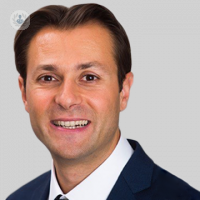Inguinal hernia: spot the signs in your child
Written by:Inguinal hernia (IH) is the abnormal passage of abdominal content (bowel, ovary, etc.) into the groin area, causing a visible bulge that can reach the scrotum in boys and the external genitalia in girls. This herniation of abdominal organs is caused by a defect in the integrity of the abdominal wall leading to the migration of the herniated content into the groin.
Leading London paediatric surgeon Mr Stefano Guiliani explains how to recognise the signs of an inguinal hernia in children, whether it poses a risk and how it can be treated.

What are the symptoms of inguinal hernia in children?
IH can be tender or pain-free depending on the organ involved and the size of the defect. Newborns may have a large bulge in the groin with normal intestinal function and no pain whilst older children may have groin and leg pain during long walks or physical activities.
What are the possible risks and complications?
If the bowel or the ovary remain trapped in the groin, they could become damaged due to pressure on the blood supply to the herniated content. This is called strangulation and could lead to that portion of the bowel or ovary dying off, which can result in serious infection, bowel problems or the loss of an ovary. This condition should be resolved urgently by a doctor and the parents should be aware to bring immediately their child to the closest hospital A&E to be assessed and treated.
Can inguinal hernia be prevented?
No. Inguinal hernia in children is a congenital problem due to the patency of a connection between the abdominal cavity and the groin. This means that there is no known way of preventing inguinal hernias and this is not due to anything a mother did during pregnancy.
How is it diagnosed?
An inguinal hernia can be easily diagnosed by an experienced paediatric surgeon. Clinical history and a detailed physical examination are sufficient to confirm the diagnosis in the majority of the cases. An ultrasound scan of the groin region may be requested to confirm the diagnosis in selected cases.
How is inguinal hernia treated?
The only possible treatment for an inguinal hernia is an operation. The operation is carried out under general anaesthetic, either using keyhole or open surgery. The surgery lasts about an hour and the child will go home the same day. Very young babies may need to stay overnight to make sure they recover safely from the general anaesthetic.


